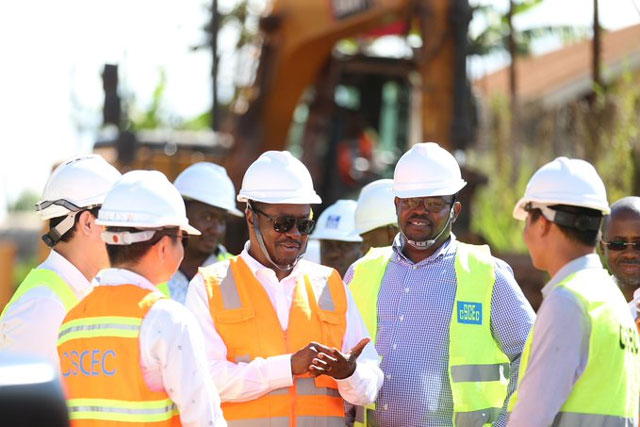
Kampala, Uganda | THE INDEPENDENT | The non-motorized stretch from Luwum street through the city centre to Namirembe road, is one of the new developments in Kampala. Even though he found it in the pipeline, this will probably be one of the projects that define the legacy of Engineer Andrew Kitaka as he ends his tour of duty as the acting Executive Director of Kampala Capital City Authority-KCCA.
Kitaka’s term of service ended on June 18, 2020, after more than 15 months in charge of the city following the resignation of Jennifer Musisi Semakula. As he took office in January 2019, Kitaka put the focus on improving Kampala’s road network through the second phase of the Kampala Institutional Infrastructure Development Project (KIIDP II).
As he waits to hand over the mantle to Dorothy Kisaka whose appointment is only pending the confirmation of the Public Service Commission, Kitaka holds a mixed report card: on one side is a congested city with heavy traffic jams and poor drainage and the other, progress in road projects and better working relationship with the political wing.
Although some of the projects are still ongoing, he scores a plus for getting them on the ground, according to a cross-section of councilors. The ongoing projects include John Babiiha, Nakawa-Ntinda road, Kulambiro ring road, Lukuli Nanganda road and Kabuusu-Bunamwaya-Lweza road.
KCCA councilor Moses Okwera says Kitaka used his experience as an engineer and the substantive Director of Engineering and Technical Services to deliver on road projects.
With only 29 billion Shillings in the kitty from the Road Fund for road maintenance, Kitaka sought funding from the Africa Development Bank and UK Export Financing Facility for more road works. This month, parliament approved a request for 830 billion Shillings (USD 224m) from ADB and 189 billion Shillings (USD 51m) for KCCA road projects.
Kitaka also secured 89 billion Shillings from the Japan International Cooperation Agency-JICA for a plan to construct 30 signaled junctions. Also on his list of options was the plan to rehabilitate the old taxi park, one of the tasks that had taken decades to accomplish. Although his plan was delayed by taxi operators who blocked the project in its initial stages, the renovations started in May 2020 and work is ongoing.
This he probably would not have been pulled off if Kitaka, had not created a cordial working relationship with the political wing at city hall, a problem that had resulted in animosity between the Lord Mayor and previous executives. But he made it a priority and when he took office, Kitaka committed to developing a cordial working relationship between the technical wing and the political leaders.
Indeed, Kitaka enjoyed a relatively good relationship with the politicians at City Hall. The bickering between Lord Mayor Erias Lukwago and technocrats had surely become rare. Nakawa Two Councilor Kennedy Okello says Kitaka is a smart administrator who avoided politics in Kampala and maintained a good relationship with political leaders.
Under Kitaka’s tenure, KCCA completed a property valuation process that would see the authority collect 50 billion Shillings in a year up from 30 billion. KCCA anticipates raising 112 billion Shillings of Non-Tax Revenue-NTR, with property tax as the biggest source.
In line with another plan to expand the landfill in Kiteezi, an extra four acres of land was recently purchased. But Olive Namazzi, the KCCA Executive Secretary in charge of health says that the score is unbalanced when it comes to public health issues.
It wasn’t a ‘bed of roses’ and like all postings, the reign did not end without bloopers. A video showing a vendor, Cissy Namukasa being swept by floods highlighted that manholes remain a prominent feature in Kampala and came off as an indictment of the authority’s failure to guarantee the safety of city dwellers. The lack of supervision for structures under construction equally raises questions.
Kitaka inherited a 27 billion Shillings legal debt arising from consent judgements entered by KCCA. His predecessor also left behind an authority that had lost over 25 billion Shillings taken off its accounts due to garnishee orders.
In 2019 Kitaka attempted to put up a fight before the High Court challenging consent judgements worth 3.4 billion Shilling saying KCCA’s representatives in court did not have the approval of management to settle through consent. The court rejected his prayer.
The cost has also kept growing with the High Court in February 2020 ordering KCCA to refund 4.8 billion Shillings to Owino market vendors for fraudulently selling their land in 2010. Court also ordered them to pay legal fees of 500 million Shillings. Similarly, in April, the High Court ordered KCCA to pay 150 million Shillings to a garbage collection company Bin It Services for defying court orders.
This raises serious questions on the operations of the authority with taxpayers punished for the ineptitude at city hall. The authority remains indebted and this is an inherited challenge Kitaka will pass over to the incoming boss.
However, Amanda Ngabirano, an urban planner, says it is hard to measure Kitaka’s achievements given that he only took forward existing plans and advised the new CEO of Kampala to have a clear master plan for the city, covering city housing, designated market areas, proper road network connected to activities in the city and proper parking areas.
She added that piece mill implementation of plans can cost money but also confuse the public.
******
URN
 The Independent Uganda: You get the Truth we Pay the Price
The Independent Uganda: You get the Truth we Pay the Price




The KCCA Executive Secretary in charge of health
Dear Madam
the system and not individuals need to reflect on these areas
How are residents complying with practice to minimize COVID-19 transmission?
How frequent are accident prone sites e.g manholes reported? (accidents do not just happen they are caused by poor work habits, faulty equipment and carelessness) the culture to attend to this should be inbuilt
[the road to Kiteezi does not look very safe to some]
How much effort is put in ensuring that residents do not burn rubbish/waste to ensure residents breathe in clean/safe air?
Which oil is being used for fast foods?
and which wrappings (some health facility records etc)?
The “protected” wells? -they were indeed protected by 1979